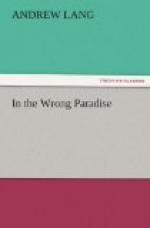“No, thanks,” he replied. “By the way, I’ve had an idea about my apparitions in disguise. Perhaps it is my ‘Unconscious Self’ that does them. You have read about the ‘Unconscious Self’ in the Spectator?”
Then he really went.
A nun in grey, who moaned and wrung her hands, remained in the room for a short time, but was obviously quite automatic.
I slept till the hot water was brought in the morning.
THE GREAT GLADSTONE MYTH. {283}
In the post-Christian myths of the Teutonic race settled in England, no figure appears more frequently and more mysteriously than that of Gladstone or Mista Gladstone. To unravel the true germinal conception of Gladstone, and to assign to all the later accretions of myth their provenance and epoch, are the problems attempted in this chapter. It is almost needless (when we consider the perversity of men and the lasting nature of prejudice) to remark that some still see in Gladstone a shadowy historical figure. Just as our glorious mythical Bismarck has been falsely interpreted as the shadowy traditional Arminius (the Arminius of Tacitus, not of Leo Adolescens), projected on the mists of the Brocken, so Gladstone has been recognized as a human hero of the Fourth Dynasty. In this capacity he has been identified with Gordon (probably the north wind), with Spurgeon, {284} whom I have elsewhere shown to be a river god, and with Livingstone. In the last case the identity of the suffix “stone,” and the resemblance of the ideas of “joy” and of “vitality,” lend some air of speciousness to a fundamental error. Livingstone is ohne zweifel, a mythical form of the midnight sun, now fabled to wander in the “Dark Continent,” as Bishop of Natal, the land of the sun’s birthplace, now alluded to as lost in the cloud-land of comparative mythology. Of all these cobwebs spun by the spiders of sciolism, the Euhemeristic or Spencerian view—that Gladstone is an historical personage—has attracted most attention. Unluckily for its advocates, the whole contemporary documents of the Victorian Dynasty have perished. When an over-educated and over-rated populace, headed by two mythical figures, Wat Tyler and one Jo, {285a} rose in fury against the School Boards and the Department, they left nothing but tattered fragments of the literature of the time. Consequently we are forced to reconstruct the Gladstonian myth by the comparative method—that is, by comparing the relics of old Ritual treatises, hymns, imprecations, and similar religious texts, with works of art, altars, and statues, and with popular traditions and folklore. The results, again, are examined in the light of the Vedas, the Egyptian monuments, and generally of everything that, to the unscientific eye, seems most turbidly obscure in itself, and most hopelessly remote from the subject in hand. The aid of Philology will not be rejected because Longus, or Longinus, has {285b} meanly argued that her services must be accepted with cautious diffidence. On the contrary, Philology is the only real key to the labyrinths of post-Christian myth.




